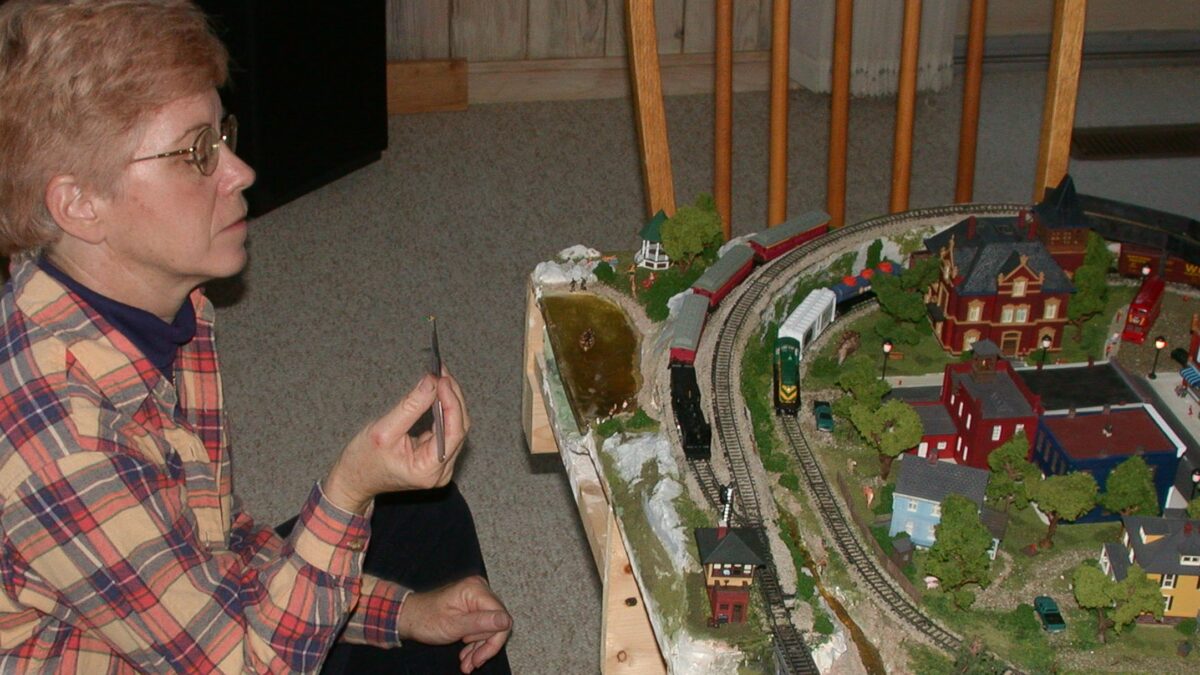North Birk
Town Development
The Town of North Birk resulted from a lifetime love of all things small—model trains and dollhouse miniatures. That interest began Christmas morning in 1953 when I received an American Flyer steam train set and a simple oval track. Santa’s gift to me. I was two just years old and it was wonderous. By 1956, that set had expanded to fill our living room. It included two engines, switches, freight and passenger rolling stock and lots of track.
Most everyone else had Lionel trains with their 3-rail tracks; American Flyer trains used just two rails and were more realistic.
Here Dad is checking the red passenger cars while being carefully watched by my sister, age 4 months. With the trains running and belching realistic, smelly smoke—1956 was an exciting Christmas!

Flash forward to 1959. We had moved to New Jersey and if you went down into our basement—this is what you would find. Our American Flyer trains on a permanent layout with a huge mountain, tunnels, bridges and buildings. Some buildings were scratch built but many, like the hospital and house-under-construction were Plasticville.
Every house we moved into had to have a basement and in the basement, there was always a wood shop, a laundry room and a darkroom. Needless to say, we spent a lot of time in the basement making things and working on the train set.

At the time, Dad worked in New York City. One day he stopped at the hobby shop in Grand Central Station and came home with his first HO-scale trains. Lionel Trains are O scale (1:48), American Flyers are S (1:64) and HO is 1:87—with HO you can pack more into a smaller layout and still have exacting detail. We had suddenly moved from toy train to scale-model railroading.
Into the attic went the big American Flyer trains, replaced by this layout based on the 1958 book “HO Railroad that grows.” The level of detail was intense—the trains rode on brass rails which Dad hand-laid using tiny rail spikes. It was fabulous—with a lake, mountain, lights, buildings and a cool electrical control panel. Dad was really into it and so was I. Most everything was scratch built. That’s my friend Jerry and I working, or more likely playing with the trains in 1961.
In 1964 the layout made the move with us to Connecticut, but unfortunately it didn’t fit into the new basement—and it was sold for $100.

Jump forward to 1984. We were living on the Outer Banks of North Carolina. My American Flyer trains, which have moved from one attic to the next, have temporarily taken over the garage floor. We have switches, buildings and a tunnel. The girls have even added some of their own accessories.
Surprisingly, 30 years later it still runs and it’s exciting to see the train chugging around the track—rekindling a little of that model train magic.
This did not happen often—only once, then back into the attic. But that garage train layout sparked a renewed model train interest.

With no basement, the American Flyer was just too big. Our daughter Sara was given an old Bachmann N gauge trainset and we had fun setting it up and running it on the base of our coffee table. N gauge at a scale of 1:160 is smaller than HO—but could fit into a coffee table. So, in ~1990 that’s what we started designing. Suddenly we needed track, switches, a layout plan, rolling stock and buildings.
Fortunately, I was able to find a copy of the HO Railroad That Grows (in it’s 11th printing!). Unfortunately, that layout wouldn’t fit in our 28”x36” table, so we improvised. We developed a track and construction plan with a mountain, stream, ocean and a town center. The project moved ahead, but slowly as I tended to work and life and our girls went about growing up.
Then in 2000, with a spark from Sara and help from her cousin Glen—and in a flurry of tree-making, grass spreading, and mountain decorating, the coffee table town of North Birk was finally finished and the tiny trains were running.



The table is quite the conversation piece. We hand visitors a scavenger hunt list of things to find along with a flashlight and enjoy watching them explore. If it was a big group, we turned it into a competition—until in a competitive frenzy someone leaned too heavily on the glass top and broke it.
Through the years, the table has had some minor updates—more accessories and different trains, including the addition of Tomy Thomas the Tank Engine, right around the time of the arrival of a granddaughter. Here Peg is using tweezers to add a tiny football team.
—Bill Birkemeier, 2022

